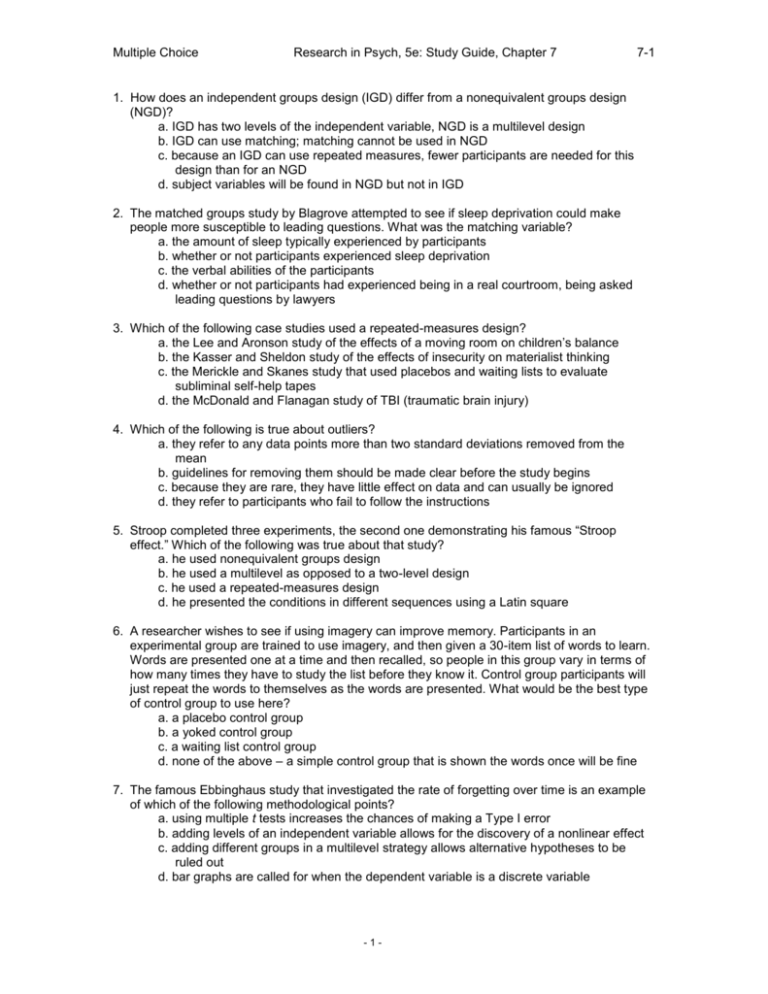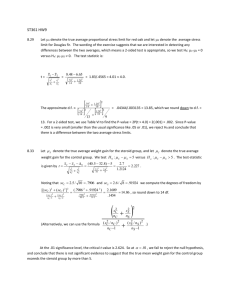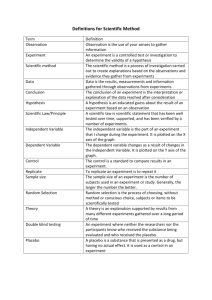Chapter 1
advertisement

Multiple Choice Research in Psych, 5e: Study Guide, Chapter 7 7-1 1. How does an independent groups design (IGD) differ from a nonequivalent groups design (NGD)? a. IGD has two levels of the independent variable, NGD is a multilevel design b. IGD can use matching; matching cannot be used in NGD c. because an IGD can use repeated measures, fewer participants are needed for this design than for an NGD d. subject variables will be found in NGD but not in IGD 2. The matched groups study by Blagrove attempted to see if sleep deprivation could make people more susceptible to leading questions. What was the matching variable? a. the amount of sleep typically experienced by participants b. whether or not participants experienced sleep deprivation c. the verbal abilities of the participants d. whether or not participants had experienced being in a real courtroom, being asked leading questions by lawyers 3. Which of the following case studies used a repeated-measures design? a. the Lee and Aronson study of the effects of a moving room on children’s balance b. the Kasser and Sheldon study of the effects of insecurity on materialist thinking c. the Merickle and Skanes study that used placebos and waiting lists to evaluate subliminal self-help tapes d. the McDonald and Flanagan study of TBI (traumatic brain injury) 4. Which of the following is true about outliers? a. they refer to any data points more than two standard deviations removed from the mean b. guidelines for removing them should be made clear before the study begins c. because they are rare, they have little effect on data and can usually be ignored d. they refer to participants who fail to follow the instructions 5. Stroop completed three experiments, the second one demonstrating his famous “Stroop effect.” Which of the following was true about that study? a. he used nonequivalent groups design b. he used a multilevel as opposed to a two-level design c. he used a repeated-measures design d. he presented the conditions in different sequences using a Latin square 6. A researcher wishes to see if using imagery can improve memory. Participants in an experimental group are trained to use imagery, and then given a 30-item list of words to learn. Words are presented one at a time and then recalled, so people in this group vary in terms of how many times they have to study the list before they know it. Control group participants will just repeat the words to themselves as the words are presented. What would be the best type of control group to use here? a. a placebo control group b. a yoked control group c. a waiting list control group d. none of the above – a simple control group that is shown the words once will be fine 7. The famous Ebbinghaus study that investigated the rate of forgetting over time is an example of which of the following methodological points? a. using multiple t tests increases the chances of making a Type I error b. adding levels of an independent variable allows for the discovery of a nonlinear effect c. adding different groups in a multilevel strategy allows alternative hypotheses to be ruled out d. bar graphs are called for when the dependent variable is a discrete variable -1- Multiple Choice Research in Psych, 5e: Study Guide, Chapter 7 7-2 8. Concerning the decision about whether to use bar graphs or line graphs, a. if the X-axis contains a discrete variable, a bar graph should be used b. if the X-axis contains a discrete variable, a line graph should be used c. if the X-axis contains a continuous variable, a bar graph must be used d. if the X-axis contains a continuous variable, a line graph must be used 9. A waiting list control group is most likely to appear in a study a. examining the effects of caffeine on steadiness b. evaluating the effects of systematic desensitization therapy on the reduction of phobias c. studying the influence of control on stress (as in the Weiss study with the rats) d. comparing males and females in their ability to not get lost 10. Which of the following is true about a study like the Bransford and Johnson study of the effects of context (the sketch of the man serenading the woman with a guitar) on memory? a. the analysis would involve a t test for independent groups rather than a t test for dependent groups b. they added levels to the independent variable in order to find a nonlinear effect c. data analysis calls for a 1-way Analysis of Variance d. the data could be presented either in a table or as a line graph 11. A researcher is interested in studying the effects of alcohol on reaction time. Participants are randomly assigned to an experimental group, a placebo control group, and a straight control group. Average reaction time in the experimental group is .36 sec. Which of the following average scores for the other two groups would allow the researcher to conclude that the apparent effect of alcohol was nothing but a placebo effect? a. the placebo group = .36 sec. and the straight control = .23 sec. b. the placebo group = .30 sec. and the straight control = .23 sec. c. the placebo group = .23 sec. and the straight control = .23 sec. d. the placebo group = .36 sec. and the straight control = .36 sec. 12. Control groups are sometimes criticized on ethical grounds – in research on therapy effectiveness, for instance, it is sometimes argued that people might be denied an effective way to solve their problems by being placed in a no-treatment control group. Researchers reply in several ways. Which of the following is not one of them? a. control groups simply aren’t used when testing the effectiveness of therapy b. control group members often get an existing therapy (rather than the experimental therapy); they aren’t denied therapy completely c. whether people would be denied a truly “effective” therapy cannot be known without completing methodologically sound (i.e., proper control groups) research d. in studies with waiting lists, the therapy is eventually available to control group members 13. When would a researcher be more likely to present data in a table rather than in a graph? a. whenever there are two levels rather than multiple levels of the independent variable b. when the researcher wants to convey the precise values of the means c. whenever the independent variable involves a discrete variable rather than a continuous variable d. none of the above – in fact, the best strategy is to present the same data both in a table and in a graph 14. For which of the following studies would a nonequivalent control groups design least likely to be used? a. a study of gender differences in sense of direction b. a study comparing “morning people” with “evening people” on several cognitive tasks c. a study examining the effects of crowding on problem solving d. a study looking at age differences in music preferences -2- Multiple Choice Research in Psych, 5e: Study Guide, Chapter 7 7-3 15. Which of the following studies would be analyzed with a t test for dependent measures? a. the study on sleep deprivation that used typical sleep time as a matching variable b. the study on the moving room that tipped over children c. the study showing that memory for a disjointed story is best for participants looking at an appropriate cartoon d. the study on the Mozart effect -3- Multiple Choice Research in Psych, 5e: Study Guide, Chapter 7 7-4 Answers 1. a. both types of designs can be either two-level or multilevel b. a matched group design is a different type of design from both IGD and NGD; with NGD however, researchers often try to equate the groups as much as possible on a number of variables c. an IGD does not use repeated measures d. CORRECT ANSWER – the presence of subject variables defines the NGD 2. a. CORRECT ANSWER –groups were matched in terms of “self-reported habitual sleep duration” b. this was the independent variable c. this might possibly have influenced the results, but Blagrove did not use it for matching d. not especially relevant 3. a. CORRECT ANSWER – the children experienced the room moving forward and backward b. this was an independent groups study c. these types of controls (placebo, waiting list) imply the existence of different groups d. this was a nonequivalent groups design 4. a. a more likely criterion is 4-5 standard deviations away from the mean b. CORRECT ANSWER – it is dangerous to remove data “after the fact” (might suggest discarding data that fail to support the hypothesis, which is fraud c. they can have a large and distorting effect on mean scores d. this is one scenario that can produce an outlier score, but outliers can occur for a number of reasons 5. a. participants completed both the Stroop condition and the control condition b. he used a two-level design c. CORRECT ANSWER d. he used a reverse counterbalancing procedure 6. a. this type of group is best used in situations in which you want participants to think they are experiencing some effect (e.g., alcohol) but really aren’t b. CORRECT ANSWER – if two experimental group participants use, say, 6 and 8 trials to learn the list, there ought to be two control group participants who study the list (without imagery) for 6 and 8 trials c. this type of group is best used in situations in which you want participants to similar to the people who are getting treatment d. those in the experimental group are studying the lists varying number of times; that needs to be true of those in the control group also 7. a. actually, the Ebbinghaus studies were completed before t tests were invented b. CORRECT ANSWER –and a nonlinear effect is just what Ebbinghaus found c. this is another reason for adding levels, but not the reason used by Ebbinghaus d. this is true, but Ebbinghaus used a continuous variable (time between learning a list and relearning it 8. a. CORRECT ANSWER b. a line graph implies intermediate points, which don’t exist with discrete variables c. with a continuous variable, line graphs are normally used, but a bar graph could be used d. with a continuous variable, line graphs are normally used 9. a. this calls for a placebo control group b. CORRECT ANSWER – waiting list controls are typically used in studies evaluating therapy; this creates two groups with similar problems -4- Multiple Choice Research in Psych, 5e: Study Guide, Chapter 7 7-5 c. this calls for a yoked control group d. this type of study does not have a control group per se 10.a. because it is a multilevel design, neither type of t test is appropriate b. they added levels to rule out alternative hypotheses c. CORRECT ANSWER d a table would be fine, but a bar graph is called for here (discrete variable on the X-axis) 11. a. CORRECT ANSWER – expecting alcohol yields exactly the same results as actually getting alcohol b. this suggests both a true effect of alcohol (.36 minus .30) and a partial placebo effect (.30 minus .23) c. this indicates no placebo effect at all, but a clear effect due to alcohol d. this indicates no effect of either a placebo or the alcohol 12. a. CORRECT ANSWER - waiting list control groups or groups given another form of therapy are normally used in this kind of research, so this argument would not be made b. this argument is frequently made c. this argument is also made d. so is this one 13. a. with just two levels, the data would best be presented as a graph or perhaps just verbally, worked into a sentence in the results section of the report b. CORRECT ANSWER – exact values usually have to be guessed at with a graph c. irrelevant – this distinction relates to the decision about whether to use a line or a bar graph d. actually, this is the one thing you should never do 14. a. subject variable used here – gender b. subject variable used here – type of person c. CORRECT ANSWER -- crowding would probably be manipulated by randomly assigning participants to a crowded or an uncrowded room d. subject variable used here – age 15. a. CORRECT ANSWER – this is a matched groups design b. this was a repeated measures design c. this study had multiple levels – calls for ANOVA d. this was a repeated measures design (with multiple levels) -5-











